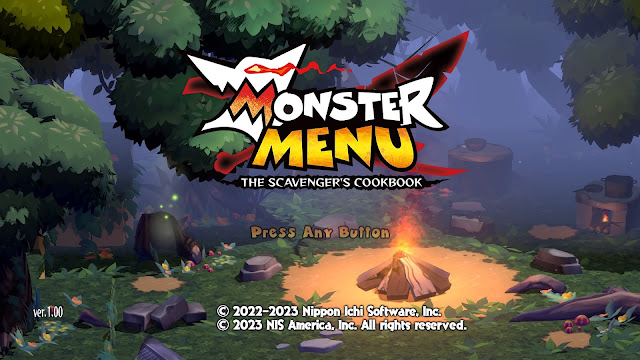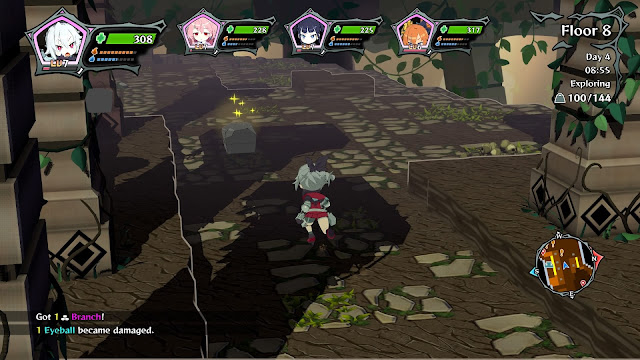Estimated reading time: 6 minute
Well folks, it's around the time a new roguelite comes out, which means my blood pressure is skyrocketing and my tears are flowing. This time we get to take a look at the NIS starvation roguelite Monster Menu: The Scavenger's Cookbook.
Monster Menu, like a large amount of roguelites, has a pretty basic premise. You're an adventurer who has gone on what was supposed to be a fairly standard adventure. Unfortunately, you get lost and run out of food and water. In a semi delirious haze, you resort to the only thing you can: eating the corpse of an unknown monster on an altar, always the best of ideas. Next thing you know, you find yourself in a sprawling labyrinth, with only a few items at your disposal. Good news though, you can't really die! You just wake up at a base camp whenever you should otherwise die. Too bad you still need to survive in order to find your way out of the labyrinth.
Like most roguelites, you are tasked with making your way through randomly generated floors to reach your goal. In monster menu, every new run sets you back down to level one, and depending on difficulty will also get rid of your materials. You do get to keep equipment though, which isn't really the most common. Monster Menu also has a few other little quirks that set itself apart from the crowd. So, let's take a look at some of the basics first.
Exploration of each new floor is done in a 3D manner, where your main character, one of up to four, will be able to walk around, harvest items, pick fights with enemies, and investigate altars. Exploration is done in a real-time scenario, where the enemies and you can be constantly moving. When you make contact with an enemy, whether that be on your terms or theirs, the field map turns into a turn-based grid style map where your combat is performed in a turn order. In combat you can attack, use skills or items, defend, etc. After winning fights, you gain exp for your units, and can then scavenge the bodies for materials. When back on the field map, your goal is to find the stairs leading to the next floor, a task sometimes easier said than done.
Why is it so difficult? Well, a number of factors really, including: how the RNG treats you, the fact that time passes, your calorie and hydration values, where the stairs have decided to appear, and what sort of materials you're able to harvest. All of these aspects tie in to the major mechanic of Monster Menu: eating food. Your units all have an individual stat layout for health, calories, hydration, and happiness. It is your job to manage these values in order to keep your party in fighting shape. The only problem is, everything you do takes energy in the form of calories and hydration. Moving, attacking, harvesting, resting between floors, even just waiting around while time passes will cause your energy to slowly deplete.
In order to restore your calories and hydration, as well as give you some extra health, you will be cooking meals between floors as you investigate the labyrinth you find yourself trapped in. Point of note, materials will decay over time, reducing their freshness until they eventually become rotten. At your camp between floors, you can use ingredients to cook meals. Tastier meals made from more normal items will restore larger amounts of health, calories, hydration, and happiness. Disgusting meals, like a plate full of maggots, may give a good calorie value but your happiness takes a nosedive. When your units get too unhappy they may become prone to madness, so look out.
Meals can be prepared using a variety of different techniques, each possibly resulting in some sort of change to the dish, which will not only restore points, but will also give you food skills as well as increase stats. If you make a meal you can't take it with you into the labyrinth though, so you need to eat it at the camp. Trying to balance making meals that provide good recovery or stats while still remaining fresh can be a challenge, especially when you lose a lot of energy values every floor, and enemies and material harvesting points just don't cough up what you need. Additionally, at night time monsters get more active, and a lot tougher, so beware.
As you explore through the floors, you may run across some skeleton bones. These have a chance at netting you some crafting recipes, for both key items and repair kits, as well as cooking recipes. Good news, you also keep these on death, although you can actually cook freeform without a recipe, although it may be quite difficult to come up with a menu item if you have no clue what you can throw together, or what type of preparation is required.
Equipment can be gathered in chests found throughout the floors, and isn't necessarily of a level tied to the floor. *stares angrily at the starter cloak found in the 3rd strata*. Thankfully your gear carries over between runs but, uh, well, it has durability, so too many failed runs without any decent rolls on materials or equipment and your gear will be a lot less beneficial. It doesn't break thankfully, so you just need to make some repair kits, if you can.
So, I have to mention this, but game is tough. Like, seriously, depending on your luck and difficulty setting this game can be an absolute nightmare. It took me, like, more than a few hours just to get into the third area, and I never found any equipment better than what I had picked up in the first area. Like seriously, it was a rough go. On the other hand, I did manage to get rather good at goading enemies into locations I wanted them in, as well as hanging onto items I could feed to enemies to cause status debuffs or negative status effects.
Monster Menu is pretty fun, and the attention to the calorie and hydration aspects are an interesting focus, especially considering how you have to either make your own meals out of materials found in the labyrinth or through devouring the corpses of your enemies mid battle. It's certainly full of a lot of interesting parts that more veteran players may enjoy, and the cute chibi characters provide a nice contrast against the grim reality that you may be eating your own comrades in order to survive.
Overall, despite being hammered upside the face by poor equipment drops and RNG rolls, I am actually quite fond of Monster Menu: The Scavenger's Cookbook. The transition from freeform exploration to turn-based battles is smooth, the combat is pretty smooth, and it's interesting being able to shove your food materials into monster faces for your own benefit. If you're expecting pity though, you may be out of luck as a lot of your run depends on how lucky you are, which may be a little frustrating for some. Monster Menu definitely feels more like a title for those familiar with the roguelite genre as opposed to newcomers, but still provides the difficulty selection to allow for newcomers to play.
Score: 7.5 / 10


















0 comments:
Post a Comment